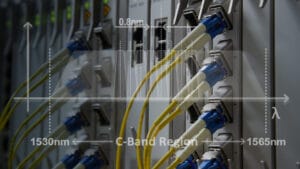
What makes an optical transceiver compatible with a switch? How can a switch distinguish a 10km part from an 80km part? A short but powerful bit of code contained in an EEPROM. Read on to learn more about what this code does (and does not) do for your transceivers.
What Is an EEPROM?
The EEPROM, orElectronicallyErasableProgrammableRead-OnlyMemory, is a small (under 1MB), compact type of non-volatile memory that is used to store relevant information about the transceiver. This information is written in a specific order in bytes of hexadecimal code and is read by the switch to determine compatibility and basic functionality of the transceiver. Many OEMs will use EEPROM coding to “close” their ports, constraining full functionality to only their own products.
The precise size and arrangement of the information
- Serial ID.The most critical information needed to identify a transceiver is contained in this section. It includes unique unit-specific information (including serial number and encoding date) as well as more general information about the product itself (e.g., Module Identifier, which names the specific form factor, and Ethernet Application Code, from which a switch will interpret the rated distance).
- Calibration.This section contains digital optical monitoring (DOM). This includes alarm thresholds for parameters including power consumption, operating temperature, and more, all monitored in real time.
- Reserved.This section is effectively a catch-all for additional tables and information not explicitly specified in the MSA. Manufacturers may include additional information here at their discretion. This information will rarely affect performance, compatibility, or interoperability, and may not appear on EEPROM printouts from switches.
EEPROMs and MSAs
For open standards-based transceivers, the EEPROM is mostly dictated by the form factor’s multi-source agreement (MSA). The MSA is an agreement between multiple manufacturers to make standardized products which will be compatible across a range of telecoms vendors’ hardware. Such agreements act as ade factostandard and have created a competitive market for MSA-compliant optical transceivers, certain cables, and other pluggable network devices.
序列和分配siz MSA将决定e of each field, but not always theexactvalue in each field. Therefore, there can be a moderate degree of variance among transceivers from different manufacturers, most of which will not directly affect functionality.
Furthermore, the MSA for a given form factor is not a static document; it evolves over time as technology advances and changes. With each new revision, fields are often added, or their sequence may change. Therefore, an older transceiver’s EEPROM may appear to be missing information when compared to a transceiver in compliance with a newer MSA, but both are in full compliance with respective MSA revisions, and EEPROM discrepancies will have no impact on their ability to interoperate.
NOTE:While EEPROMs give important information to switches about what part is deployed, it isnotpossible to “enhance” a transceiver by simply changing its EEPROM. For example, if you have a 10GE-LR (10km) part, you cannot change it to a functional 10GE-ZR (80km) part by recoding the EEPROM. The switch may read it as such, but the hardware components of the transceiver are not designed to cover this extended distance.
In just a small bit of code, EEPROMs govern all aspects of transceiver performance and compatibility. Got any further questions about compatibility? Our experts would be happy to help. Give us a call at 800.860.7640, orsubmit an inquiry, and we’ll be in touch shortly.

